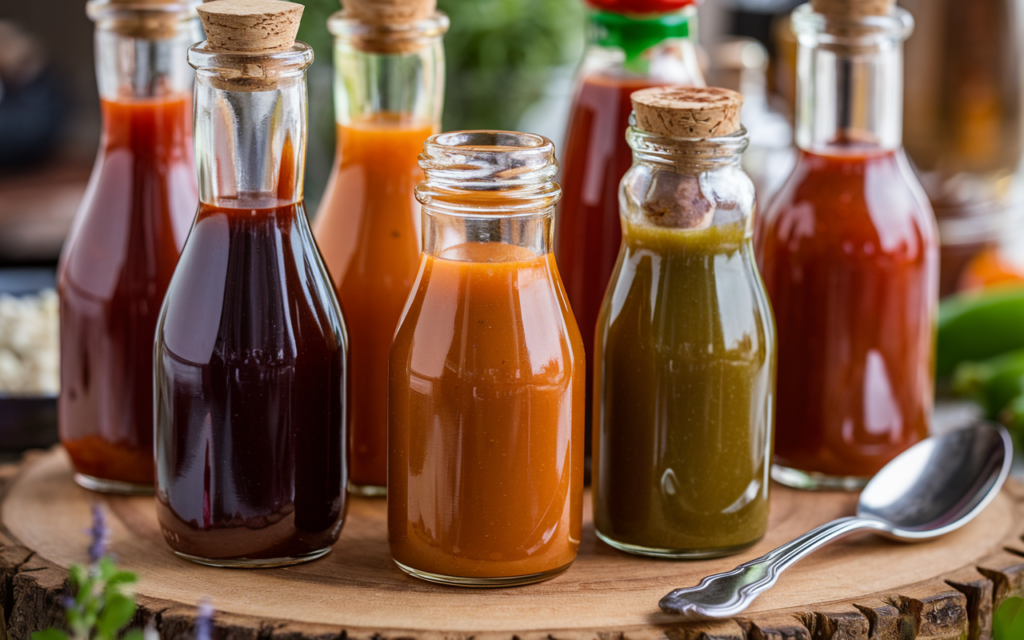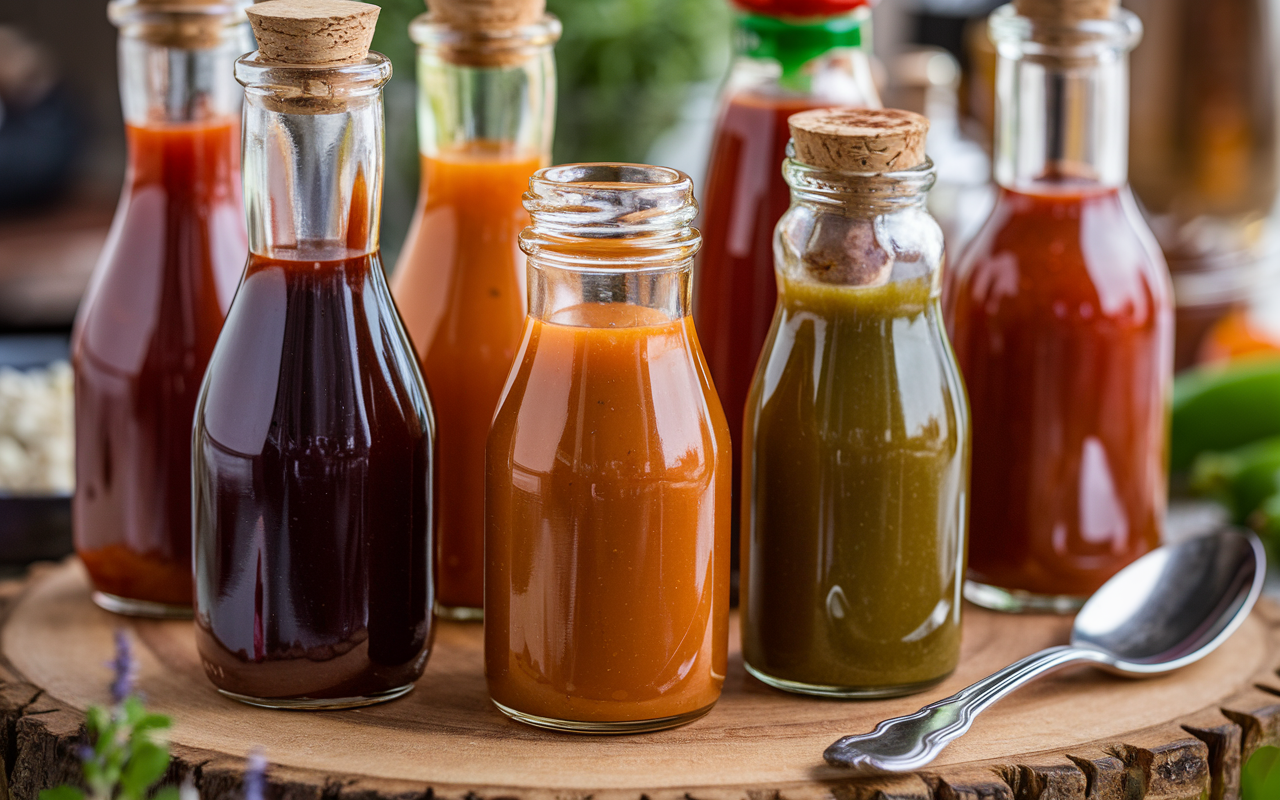Discover how to make Hot Sauce Recipe.
with this comprehensive guide. Whether you’re a spice enthusiast or a curious home cook, this article will take you step-by-step through the process of creating your own hot sauce. We’ll cover everything from ingredient selection to flavor combinations, ensuring you end up with a hot sauce that packs just the right amount of heat.
Table of Contents
- What Makes a Great Hot Sauce?
- Ingredients Needed for Your Hot Sauce Recipe
- Step-by-Step Hot Sauce Recipe
- Tips for Perfecting Your Hot Sauce Recipe
- Flavor Variations and Creative Additions
- The Science of Hot Sauce Fermentation
- Common Mistakes and How to Avoid Them
- Storing and Preserving Your Hot Sauce
- Pairing Hot Sauce with Food
- Frequently Asked Questions
- Conclusion
- Suggested Internal Links
What Makes a Great Hot Sauce?
The best hot sauce recipe is one that balances heat, acidity, and flavor. Many hot sauces are made with just a few simple ingredients: hot peppers, vinegar, salt, and sometimes a touch of sugar. However, the real magic happens when you adjust the ratios and add your own creative twists. Therefore, let’s dive into the ingredients that form the backbone of any hot sauce.
Hot peppers are the key component of any hot sauce. The variety you choose will influence the final heat level and flavor profile of your sauce. For example, using habanero peppers will give you a very hot, fruity flavor, whereas jalapeños will result in a milder, earthier sauce.
For more information on the types of peppers that work best for making hot sauce, you can check out this detailed guide to chili peppers from MasterClass. Additionally, if you’re interested in learning about the benefits of spicy foods, take a look at Healthline’s article on why spicy foods can be good for you.
Ingredients Needed for Your Hot Sauce Recipe
Creating your own hot sauce recipe requires some basic ingredients and tools. Below is a list of everything you’ll need to get started:
- Hot Peppers: Depending on your desired heat level, you can use cayenne, habanero, jalapeño, or even ghost peppers for the boldest spice.
- Vinegar: Vinegar adds acidity, which helps preserve the hot sauce and enhances its flavor.
- Salt: Salt plays a crucial role in balancing flavors and drawing out moisture from the peppers.
- Garlic (Optional): Adds depth and richness to the sauce.
- Sugar (Optional): A touch of sugar can balance out the acidity and heat for a more rounded flavor.
In addition to the above ingredients, you may need a few tools, such as a blender or food processor, a saucepan, and glass bottles for storage.
Types of Peppers to Use in Hot Sauce
The type of pepper you choose will have a significant impact on the flavor and heat of your hot sauce. Here are some popular options:
- Jalapeño Peppers: These are perfect if you prefer a milder heat. Jalapeños have an earthy flavor and add a moderate amount of spice.
- Habanero Peppers: Habaneros are known for their intense heat and fruity flavor. They are ideal for a very spicy hot sauce.
- Cayenne Peppers: Cayenne peppers provide a sharp, pungent heat that is common in many store-bought hot sauces.
- Ghost Peppers: For those who love extreme heat, ghost peppers (Bhut Jolokia) are one of the hottest options you can use.
- Serrano Peppers: Serranos offer a balance of flavor and heat, falling somewhere between jalapeños and habaneros.
- Scotch Bonnet Peppers: Often used in Caribbean cuisine, Scotch bonnets have a heat level similar to habaneros but a slightly sweeter, more tropical flavor.
Different Types of Vinegar for Hot Sauce
Vinegar plays a crucial role in any hot sauce recipe. It not only adds acidity but also helps to preserve the sauce, extending its shelf life. Here are some types of vinegar you can use in your hot sauce:
- White Vinegar: This is the most common type of vinegar used in hot sauces. It has a clean, sharp flavor that lets the heat of the peppers shine.
- Apple Cider Vinegar: Apple cider vinegar adds a slightly sweet, fruity note to your hot sauce, making it a great choice for recipes with a sweeter flavor profile.
- Rice Vinegar: Rice vinegar is milder and slightly sweet, which can help balance the heat in your hot sauce.
- Red Wine Vinegar: This vinegar adds a richer, more complex flavor, ideal for a deeper, more robust hot sauce.
Step-by-Step Hot Sauce Recipe
Step 1: Prepare Your Peppers
Before you start making your hot sauce, make sure to select high-quality hot peppers. Rinse them thoroughly and remove the stems. For a milder sauce, you can also remove the seeds and membranes, as these are where most of the heat is concentrated.
Consider wearing gloves when handling hot peppers, especially if you are working with extremely hot varieties like habaneros or ghost peppers. The oils from the peppers can irritate your skin and eyes.
Step 2: Blend the Ingredients
Place the peppers in a blender, along with your chosen vinegar, salt, and any additional ingredients (such as garlic or sugar). Blend until you achieve a smooth consistency. Depending on your preference, you can adjust the amount of vinegar to make the sauce thinner or thicker.
You can also add fruits like mango or pineapple at this stage to create a fruity hot sauce. This adds a nice sweetness that can balance out the heat.
Step 3: Cook the Sauce
Pour the blended mixture into a saucepan and bring it to a boil. Reduce the heat and let it simmer for about 10-15 minutes. This helps to meld the flavors together and reduce any raw pepper taste. Remember to stir occasionally to prevent sticking.
Cooking the hot sauce also helps to thicken it slightly and intensify the flavors. If you prefer a raw, fresh-tasting hot sauce, you can skip this step, but note that it will have a shorter shelf life.
Step 4: Strain (Optional)
For a smoother sauce, you can strain the mixture through a fine-mesh sieve to remove any solids. If you prefer a chunkier hot sauce, you can skip this step.
Straining is particularly helpful if you plan to bottle your hot sauce in a bottle with a narrow neck. A smoother consistency will make it easier to pour.
Step 5: Bottle and Store
Allow the hot sauce to cool before transferring it to glass bottles. Store the hot sauce in the refrigerator, where it will keep for several months.
Glass bottles are ideal for storing hot sauce, as they do not react with the acidic vinegar. Make sure to use clean, sterilized bottles to avoid contamination.
Tips for Perfecting Your Hot Sauce Recipe
- Experiment with Pepper Combinations: Mixing different types of peppers can result in a more complex flavor profile. For example, combining habaneros with bell peppers can give you a nice balance of sweetness and heat.
- Add Fruits for Sweetness: If you want a hot sauce with a fruity twist, try adding ingredients like mango, pineapple, or peaches. These fruits can add a natural sweetness that complements the heat of the peppers.
- Control the Acidity: The type of vinegar you use will have a significant impact on the flavor. White vinegar is classic, but apple cider vinegar can add a touch of sweetness, while rice vinegar adds a milder tang.
- Fermentation: For a more complex flavor, try fermenting your hot sauce. To do this, blend the peppers with salt and let the mixture ferment in a jar for 1-2 weeks before adding vinegar and blending again. Fermented hot sauces have a distinct, tangy flavor that many people love.

Flavor Variations and Creative Additions
Hot sauce is highly customizable, and there are countless ways to make it your own. Here are some ideas for flavor variations and creative additions:
Adding Herbs and Spices
- Cilantro: Adding fresh cilantro can give your hot sauce a fresh, herbal flavor.
- Oregano: Dried oregano adds a savory note that pairs well with the heat of the peppers.
- Cumin: A pinch of cumin can add a smoky, earthy depth to your hot sauce.
- Smoked Paprika: Smoked paprika can add both color and a smoky flavor to your hot sauce.
Adding Sweeteners
Sweeteners can help balance out the heat and acidity of your hot sauce. Here are some options:
- Honey: Honey adds a rich sweetness that pairs well with hot peppers.
- Brown Sugar: Brown sugar adds a deeper, molasses-like sweetness.
- Maple Syrup: Maple syrup can add a unique, slightly caramelized flavor to your hot sauce.
Adding Vegetables
Adding vegetables can enhance the flavor and texture of your hot sauce:
- Carrots: Carrots add sweetness and body to the sauce.
- Onions: Onions add a savory, slightly sweet flavor that complements the heat.
- Tomatoes: Tomatoes can add acidity and sweetness, creating a more balanced sauce.
The Science of Hot Sauce Fermentation
Benefits of Fermenting Hot Sauce
Fermentation is a natural process that not only enhances the flavor of your hot sauce but also provides health benefits. During fermentation, beneficial bacteria break down the sugars in the peppers, creating lactic acid. This process adds a tangy complexity to the flavor of your hot sauce and makes it easier to digest. Fermented hot sauce is also rich in probiotics, which are beneficial for gut health.
How to Ferment Hot Sauce
To ferment your hot sauce, follow these steps:
- Prepare the Peppers: Start by chopping your peppers and placing them in a clean jar. Add a few cloves of garlic or other flavoring agents, if desired.
- Add Salt: Sprinkle salt over the peppers. Use about 3% of the total weight of the peppers. Salt is essential for fermentation, as it inhibits the growth of harmful bacteria while allowing beneficial bacteria to thrive.
- Add Water: Pour in filtered water until the peppers are submerged. Make sure all the peppers are fully covered to prevent mold from forming.
- Ferment: Cover the jar with a loose-fitting lid or a fermentation airlock. Let the mixture sit at room temperature for 1-2 weeks. Taste the hot sauce periodically to see how the flavor develops.
- Blend and Bottle: Once the fermentation process is complete, blend the mixture until smooth. Add vinegar to taste, then bottle and store in the refrigerator.
Fermented hot sauces have a distinct, tangy flavor that adds depth to any dish. The fermentation process can take anywhere from a few days to several weeks, depending on your desired flavor.
Common Mistakes and How to Avoid Them
Making hot sauce at home can be a rewarding experience, but there are some common mistakes that can lead to disappointing results. Here are some mistakes to avoid:
- Using Low-Quality Peppers: The quality of your peppers will significantly impact the final flavor of your hot sauce. Always use fresh, high-quality peppers for the best results.
- Not Wearing Gloves: Handling hot peppers without gloves can lead to skin irritation or burning. Always wear gloves when chopping and handling peppers, especially hot varieties like habaneros or ghost peppers.
- Not Balancing Flavors: Hot sauce should be a balance of heat, acidity, and flavor. If your sauce is too acidic, try adding a touch of sugar to balance it out. If it’s too hot, consider adding more vinegar or blending in a milder pepper.
- Overcooking the Sauce: Cooking hot sauce for too long can lead to a loss of freshness and flavor. Simmer the sauce just long enough to meld the flavors without overcooking.
- Improper Storage: Hot sauce should be stored in clean, sterilized bottles to prevent contamination. Always refrigerate your hot sauce to maintain its quality and extend its shelf life.
Storing and Preserving Your Hot Sauce
Once you’ve made your hot sauce, proper storage is key to maintaining its flavor and quality. Here are some tips for storing and preserving your hot sauce:
- Refrigeration: Most hot sauces will keep well in the refrigerator for several months. The vinegar and salt act as natural preservatives, but refrigeration will help maintain the best flavor.
- Fermented Hot Sauces: If you have fermented your hot sauce, it will have a longer shelf life due to the beneficial bacteria created during fermentation. Fermented hot sauces can often be stored at room temperature, but refrigeration is still recommended for the best quality.
- Freezing: Hot sauce can be frozen if you want to store it for an extended period. Pour the hot sauce into ice cube trays and freeze. Once frozen, transfer the cubes to a freezer bag for easy portioning.
Pairing Hot Sauce with Food
Hot sauce can enhance the flavor of almost any dish. Here are some ideas for pairing your homemade hot sauce with food:
Breakfast Dishes
- Eggs: Hot sauce is a classic addition to scrambled eggs, omelets, or fried eggs. The heat cuts through the richness of the eggs, adding a burst of flavor.
- Avocado Toast: A few drops of hot sauce on avocado toast can elevate the dish, adding a spicy kick that complements the creamy avocado.
- Breakfast Burritos: Hot sauce pairs perfectly with breakfast burritos, adding a layer of heat that complements the savory fillings.
Lunch and Dinner Dishes
- Tacos and Burritos: Hot sauce is a must-have for tacos and burritos. Whether you’re making chicken, beef, or veggie tacos, a drizzle of hot sauce adds the perfect amount of spice.
- Grilled Meats: Hot sauce can be used as a marinade or finishing sauce for grilled meats like chicken, steak, or pork. The acidity helps tenderize the meat, while the heat adds a burst of flavor.
- Soups and Stews: Adding a dash of hot sauce to soups and stews can enhance the flavor, adding complexity and heat to the dish.
Snacks and Appetizers
- Wings: Hot wings are a classic snack that pairs perfectly with hot sauce. Toss cooked wings in your homemade hot sauce for a spicy, flavorful treat.
- Nachos: Drizzle hot sauce over nachos for an added kick. It pairs well with the cheese, beans, and other toppings.
- Dips: Mix a little hot sauce into your favorite dip, such as hummus or sour cream, to add an extra layer of flavor.
Frequently Asked Questions
What Are the Main Ingredients in Hot Sauce?
The main ingredients in hot sauce are hot peppers, vinegar, and salt. Additional ingredients like garlic, sugar, or fruits can be added to create more unique flavors.
How Did They Make Hot Sauce?
Hot sauce has been made for centuries using basic preservation techniques. Traditionally, peppers are blended with vinegar and salt, then fermented or cooked to create a flavorful condiment.
What Makes the Perfect Hot Sauce?
The perfect hot sauce is one that balances heat, acidity, and flavor. Personal preferences vary, so it’s all about finding the right combination of ingredients that suits your taste buds.
What Is Vinegar Hot Sauce?
Vinegar hot sauce refers to hot sauces where vinegar is the primary liquid used. It not only adds acidity but also helps preserve the hot sauce, ensuring a longer shelf life.
Conclusion
Making your own hot sauce recipe at home can be a fun and rewarding experience. By selecting the right combination of peppers, vinegar, and other ingredients, you can create a hot sauce that perfectly suits your taste. Whether you like it mild or blazing hot, sweet or smoky, this guide provides everything you need to craft a hot sauce that’s uniquely yours. Don’t be afraid to experiment and make adjustments to create the perfect blend for your taste buds. Happy hot sauce making!

